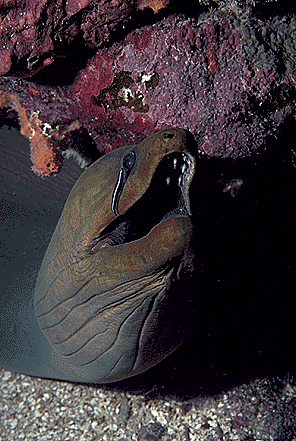
There are 80 or more species of eels of the family Muraenidae. Moray eels occur in all tropical and subtropical seas. They live in shallow water among reefs and rocks and hide in crevices. They differ from other eels in having small rounded gill openings and in generally lacking pectoral fins. Their skin is thick, smooth, and scaleless, while the mouth is wide and the jaws are equipped with strong, sharp teeth, which enable them to seize and hold their prey (chiefly other fishes) but also to inflict serious wounds on their enemies, including humans. They are apt to attack humans only when disturbed, but then they can be quite vicious.
Moray eels are usually vividly marked or colored. They generally do not exceed a length of about 5 feet (1.5 m), but one species, Thyrsoidea macrurus of the Pacific, is known to grow about 11.5 feet (3.5 m) long, but I’m unable to document this in the literature. Morays are eaten sometimes, but their flesh is often toxic and may cause sickness or death.
Morays enjoy rocky areas, can be found living or just “hanging out” in holes, under rocks, crevices and tidepool ledges. To prevent contact and possible severe injury keep hands out of those rocky areas, holes and crevices. If you must, use a stick to probe. If you are fishing be careful, as dead fish, blood or bait will bring them out of their holes. Frequently lobsters will be in the same hole as the eel — in this case at least two of the lobster’s antennae (feelers) will be directed backward to keep check of the eel.
They injure you with their razor sharp teeth and powerful jaws that can lock. There are two sets of teeth, a second set in the throat, making it difficult for a prey (or a human hand) to be easily withdrawn. Injuries can result in bleeding, severe muscle damage and also chipped bones. Bleeding should be stopped and the wound cleaned thoroughly. Get medical help to guard against infection.
Steps to take in case of severe trauma (of any kind)
Call for help and immediate transport
Open airway
Treat for shock on site and stabilize before evacuation
Face up neutral position
Direct pressure over bleeding wounds
CPR if no pulse or respirations
Keep warm
Be mindful of the possibility of neck injury
O2 if any question of hypoxemia (Low oxygen in the blood)
Splint limb injuries
